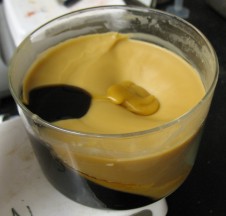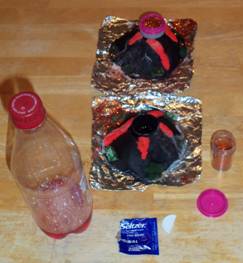Demonstrations Page 9 - Geology
Scroll down to view photographs and short descriptions of
some of the demonstrations in the list below.
WARNING – Use at your own risk! We cannot guarantee the accuracy or the safety of these activities. Some of these activities are far more dangerous than others. The contributors and Bradley University do not assume any responsibility for these activities or their results. If you have questions, corrections, or comments please do not hesitate to contact Dean Campbell (campbell@bumail.bradley.edu) at Bradley University.
- Ferrofluid
Demonstrations
- Refrigerator
Magnet Demonstrations
- Polydimethysiloxane
Demonstrations
- LEGO® Brick Chemistry and Nanotechnology Demonstrations
- Snack Layers
- To illustrate the Principle of Superposition (oldest rocks are deposited lower than more recent rocks) to a group of Kindergarteners, I poured different types and colors of snack foods into layers into a clear drink pitcher. They seemed to grasp the lowest = oldest connection quite clearly.

- Flash Rocks
- See Demonstrations Page 3 - Dipoles and Solutions.
Liquid Nitrogen Geyser
-
- CAUTION: Liquid nitrogen is very cold and presents a serious
frostbite hazard, especially if it gets trapped against your
skin (e.g.in your clothing). Additionally, gaseous nitrogen occupies
more volume than the same quantity of liquid nitrogen. Gaseous
nitrogen produced quickly enough in sufficient quantities can
displace oxygen from the air. Containers filled with liquid nitrogen
could fail without warning due to thermal shock or gas pressure.
Protect yourself accordingly.
-
-
- A geyser is a steam and water eruption (spring) water coming
into contact with a very intense underground heat source. Certain
geysers are periodic, but most of them occur in periods that
vary from seconds to hours. For a geyser to occur there has to
be heated rock underground, an abundant source of water, and
a "plumbing" system consisting of channels in the ground
that conduct water to and up away from the heated rock. Water
flowing into the plumbing system is heated many degrees over
its boiling point. Eventually the pressure of the heated water
increases to the point that water and steam will be rapidly ejected
into the air. Eventually, the plumbing system will restock itself
with water and repeat the process again.
Liquid nitrogen geysers have been observed on Neptune's moon
Triton (these are believed to erupt via a different mechanism
than here on Earth). A small liquid nitrogen geyser can be made
by placing a meter-long copper tube partially into a pool of
liquid nitrogen. The tube at room temperature is inserted into
the Dewar flask that contains some liquid nitrogen. Since the
boiling point of liquid nitrogen is 77K and the tube is approximately
room temperature (298 K), liquid nitrogen entering the tube will
quickly vaporize, pushing vapor and liquid nitrogen up the tube
into the air for a brief time.
- Reference:
- Wikipedia: Geyser. http://en.wikipedia.org/wiki/Geyser (accessed
June, 2006).
- BELOW: A liquid nitrogen geyser. The copper tube shown here
is 120 cm long with an inner diameter of 1.4 cm.
-


-
- Liquid Nitrogen Base Surge and Downburst
-
- CAUTION: Liquid nitrogen is very cold and presents a serious
frostbite hazard, especially if it gets trapped against your
skin (e.g.in your clothing). Additionally, gaseous nitrogen occupies
more volume than the same quantity of liquid nitrogen. Gaseous
nitrogen produced quickly enough in sufficient quantities can
displace oxygen from the air. Containers filled with liquid nitrogen
could fail without warning due to thermal shock or gas pressure.
Protect yourself accordingly.
-
-
- Base surges and downbursts occur when dense gases sink rapidly
down through less dense gases and spread outward upon impacting
the ground. Base surges are clouds of gas and dust that move
along the ground away from a volcanic eruption or a nuclear explosion.
It is often produced when a column of these clouds collapses
to the ground. Downbursts, and smaller microbursts, occur when
cold air sinks to the ground from a thunderstorm. A similar phenomenon
seems to occur during the filling of a typical 4 liter Dewar
flask with a relatively narrow neck from a liquid nitrogen supply
line. As the liquid nitrogen (boiling at 77 K) first passes
through the supply line and into the flask at room temperature
(about 298 K), the liquid nitrogen flashes into pressurized vapor.
The vapor rushes out of the Dewar flask, creating a column of
cool nitrogen vapor and condensed water droplets. As the supply
line cools, liquid nitrogen actually makes it into the Dewar
flask. The liquid nitrogen boils away less rapidly and the pressure
forcing the nitrogen vapor up from the Dewar flask decreases.
The cold dense vapor column then collapses down and spreads
across the ground, resembling a base surge or a downburst.
- References:
- Clark Johnson. Base Surge. http://www.geology.wisc.edu/~g111/Terms/base_surge/base_surge.htm
(accessed June, 2006).
- Denton County, Texas. Downbursts. http://www.co.denton.tx.us/dept/main.asp?Parent=82&Link=84#Mistaken
(accessed June, 2006).
-
- BELOW: A liquid nitrogen base surge: (LEFT) Formation of
the column of cool nitrogen vapor and condensed water and (RIGHT)
collapse of the column.
-


-
- Candle Wax Volcano
- It was noted that when a large candle was placed on a wood stove that the wax in the lower part of candle melted. This melted wax was less dense than the solid, and in some cases rose to the top of the candle and formed flows on the candle surface. This was reminiscent of lava flows in a non-explosive volcanic eruption, so the candle was placed on a small hot plate that could produce more localized heating within the candle. As the pictures show, the melted wax breached the top surface of the candle closest to the center of the hot plate and flowed to the lowest part of the candle surface. When the candle wax cooled and hardened, the remaining liquid wax in the source hole contracted as it became more dense, producing a sort of crater or vent.
-
- BELOW: A candle wax volcano: (LEFT) Liquid wax rising up and almost breaching the top surface of candle. (MIDDLE) The liquid wax "lava" flowing across the candle surface and pooling in a low spot. (RIGHT) When the candle wax cooled and hardened, the remaning liquid wax contracted back into the "vent".



Seltzer Popper Volcanoes
These demonstrations are a twist on the classic homemade volcano, in which vinegar and baking soda chemically react in a model of a volcano to produce sodium acetate, water, and carbon dioxide gas. The carbon dioxide bubbles up out of the model to produce bubbling “lava” which oozes out of the “volcano”. The picture below shows the same reaction in a soda bottle (food coloring and dish soap have been added to make the lava flow more impressive).

But what about the volcanoes with more explosive eruptions? Here we adapt another classic demonstration involving film canisters and Alka-Seltzer tablets. (See Demonstration Page 5 - Acids, Bases, and Indicators for a related demonstration, the Seltzer Popper Car.)
Wear eye protection. First lay down a sheet of plastic to make cleanup easier. Place a film canister into a clay volcano, setting the lid aside for now. Fill a milk cap with glitter. Fill the film canister halfway with water, with maybe a little dish soap and red and yellow food coloring for a “lava” effect. Break a tablet of Alka-Seltzer in half (any more that is wasted). Make sure everything is ready and the area is cleared out around the volcano.

Then, QUICKLY add the half-tablet of Alka-Seltzer to the film canister, cover the canister tightly with the lid, place the milk cap full of glitter on top of the lid, and take a step back (NEVER stand over the lid). The citric acid and baking soda in the tablet dissolve in the water and chemically react to produce sodium citrate, water, and carbon dioxide gas. The gas pressure builds up in the capped film canister until the lid pops off, scattering the glitter and sending reddish suds oozing down the side of the volcano.


We can also use the Alka-Seltzer tablets to illustrate the effects that size has on processes. If the half-tablet that is added to the film canister is first broken into small pieces, it will dissolve much more quickly in water to react and produce carbon dioxide gas. The result is that, with all else equal, a popper volcano with the broken-up half-tablet will pop more quickly after loading than one with an intact half-tablet. This illustrates how processes can proceed more quickly at smaller scales. For example, many people are studying how making things really small (at the nanoscale) with lots of surface area can speed up chemical reactions.
Another note: We have also noticed that a film canister fits into the top of a milk jug with just a little widening (we also colored the jug piece with permanent markers). This seems to be very inexpensive way to make a waterproof volcano cone without having to use modeling clay.

Reference: Johnsen, N. V. Nano Effervescence. http://www.exo.net/~jillj/activities/nanoeffervescence.pdf (accessed January, 2012).
Return to Dr. Campbell's Favorite
Demonstrations
Last updated 1/18/12
Site created at the laboratory of Dean Campbell













